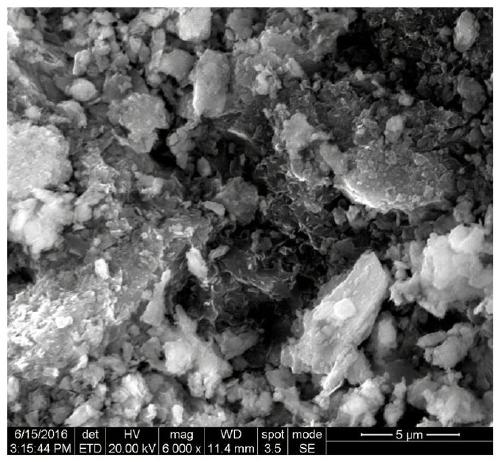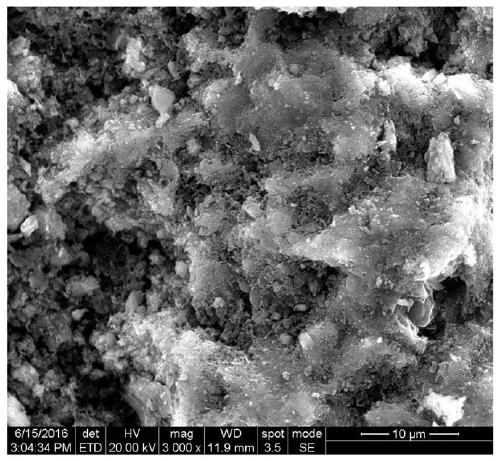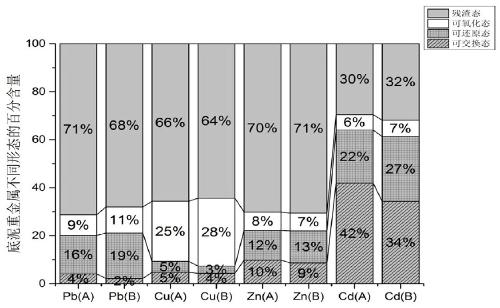Method for remediating heavy metal-contaminated sediment and method for improving farmland soil by using modified zeolite molecular sieve
A zeolite molecular sieve and modified zeolite technology, which is applied in the field of farmland soil improvement, can solve problems such as occupancy, unsatisfactory effect, and influence on adsorption efficiency, and achieve the effects of improving soil, realizing resource reuse, and improving the ability to absorb heavy metals
- Summary
- Abstract
- Description
- Claims
- Application Information
AI Technical Summary
Problems solved by technology
Method used
Image
Examples
Embodiment 1
[0034] A kind of method utilizing modified zeolite molecular sieve of the present invention to repair heavy metal polluted bottom mud, comprises the following steps:
[0035] (1) Preparation of modified zeolite molecular sieve materials
[0036] (1.1) Prepare the solution
[0037] Configure 1mol / L HNO 3 Solution: measure 12.8ml HNO 3 Add 50ml of deionized water, dilute to 200ml, stir well to get HNO 3 solution.
[0038]Prepare 1mol / L NaOH solution: weigh 8.0g NaOH and dissolve it in 200ml deionized water, stir well to obtain NaOH solution.
[0039] Prepare 0.5mol / L NaOH solution: weigh 4.0g NaOH and dissolve in 200ml deionized water, stir well to obtain NaOH solution.
[0040] Prepare chitosan solution: Weigh 10g chitosan (used to treat 10g zeolite molecular sieve) in 200ml deionized water.
[0041] (1.2) Preparation of granular zeolite molecular sieves: Grind industrial clinoptilolite molecular sieves (original form, particle size > 2mm) into small particles using a pul...
Embodiment 2
[0052] A method of using modified zeolite molecular sieve of the present invention to restore heavy metal-contaminated bottom mud, its steps are basically the same as in Example 1, the only difference is that the mass ratio of modified zeolite molecular sieve to bottom mud sample in Example 2 is 3:2 .
[0053] Speciation detection of Cu(II), Cd(II), Pb(II), Zn(II) in sediment:
[0054] Take the bottom sludge treated with the modified zeolite molecular sieve in Example 2, use the BCR continuous extraction method to carry out graded extraction of metals in the exchangeable state, reducible state, oxidizable state and residue state, and the obtained extract is determined by atomic absorption spectrometer. The content of metals; at the same time, take the unrepaired heavy metal contaminated sediment, and use the same method to detect the forms of Cu(II), Cd(II), Pb(II), Zn(II), the results are as follows Figure 4 shown. Figure 4 It is a change diagram of the content of heavy m...
Embodiment 3
[0057] A method of using modified zeolite molecular sieve of the present invention to restore heavy metal-contaminated bottom mud, the steps of which are basically the same as in Example 1, the only difference being that the mass ratio of modified zeolite molecular sieve to bottom mud sample in Example 3 is 1:9 .
[0058] Speciation detection of Cu(II), Cd(II), Pb(II), Zn(II) in sediment:
[0059] Take the bottom sludge treated with the modified zeolite molecular sieve in Example 3, use the BCR continuous extraction method to carry out graded extraction of metals in the exchangeable state, reducible state, oxidizable state and residue state, and the obtained extract is determined by atomic absorption spectrometer. The content of metals; at the same time, take the unrepaired heavy metal contaminated sediment, and use the same method to detect the forms of Cu(II), Cd(II), Pb(II), Zn(II), the results are as follows Figure 5 shown. Figure 5 It is a change diagram of the conten...
PUM
| Property | Measurement | Unit |
|---|---|---|
| particle diameter | aaaaa | aaaaa |
Abstract
Description
Claims
Application Information
 Login to View More
Login to View More - R&D
- Intellectual Property
- Life Sciences
- Materials
- Tech Scout
- Unparalleled Data Quality
- Higher Quality Content
- 60% Fewer Hallucinations
Browse by: Latest US Patents, China's latest patents, Technical Efficacy Thesaurus, Application Domain, Technology Topic, Popular Technical Reports.
© 2025 PatSnap. All rights reserved.Legal|Privacy policy|Modern Slavery Act Transparency Statement|Sitemap|About US| Contact US: help@patsnap.com



